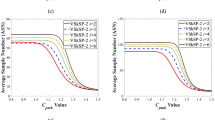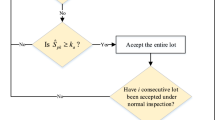Abstract
The multiple sampling plan (MSP) is an extended model and has been shown to be more efficient with some cost savings associated with its usage than the single and double sampling plans. However, the variables MSP’s operating characteristic (OC) function is complex and difficult to obtain because the judgment at the current sampling should take the preceding sample information into consideration. Therefore, this study proposes the development of a modified MSP for variables inspection by considering independence between stages and integrating with the third-generation capability index. A mathematical model with two constraints is established for obtaining triple plan parameters, which satisfy the specified risk-and-quality conditions and minimize the average sample number (ASN). Additionally, we employed two generally-used performance indicators, ASN and OC curve, to evaluate the performance of the proposed model. The results show that the proposed model provides higher efficiency than the existing plan under the same settings and offers desired protection to both stakeholders. We applied the proposed model to the monocrystalline silicon wafers industry coupled with a designed graphical user interface to validate its practicability.












Similar content being viewed by others
References
Arizono, I., Yoshimoto, K., & Tomohiro, R. (2020). Variable stage-independent double sampling plan with screening for acceptance quality loss limit inspection scheme. International Journal of Production Research, 58(8), 2550–2559.
Balamurali, S., & Usha, M. (2017). Developing and designing of an efficient variables sampling system based on the process capability index. Journal of Statistical Computation and Simulation, 87(7), 1401–1415.
Boggs, P. T., & Tolle, J. W. (1995). Sequential quadratic programming. Acta Numerica, 4, 1–51.
Bowker, A. H., & Goode, H. P. (1952). Sampling inspection by variables. McGraw-Hill.
Chan, L. K., Cheng, S. W., & Spiring, F. A. (1988). A new measure of process capability: Cpm. Journal of Quality Technology, 20(3), 162–175.
Chapra, S. C. (2012). Applied numerical methods with MATLAB for engineers and scientists (3rd ed.). McGraw-Hill.
Dey, S., Saha, M., Zhang, S., & Wang, M. (2022). Classical and objective Bayesian estimation and confidence intervals of an asymmetric loss based capability index Cpmk′. Quality and Reliability Engineering International, 38(4), 1659–1686.
Hsiang, T. C., & Taguchi, G. (1985). A tutorial on quality control and assurance-the Taguchi methods. America Statistical Association, Annual Meeting.
Hughes, H., Dickinson, P. C., & Chow, B. (1973). A computer program for the solution of multiple sampling plans. Journal of Quality Technology, 5(1), 39–42.
Kotz, N. L., & Johnson, S. (2002). Process capability indices—a review, 1992–2000. Journal of Quality Technology, 34(1), 2–53.
Kotz, S., & Lovelace, C. R. (1998). Process capability indices in theory and practice. Arnold.
Lepore, A., Palumbo, B., & Castagliola, P. (2018). A note on decision making method for product acceptance based on process capability indices Cpk and Cpmk. European Journal of Operational Research, 267(1), 393–398.
Lorenzen, T. J. (1979). The computational aspects of multiple attribute sampling procedures. Communications in Statistics - Simulation and Computation, 8(4), 291–309.
Montgomery, D. C. (2009). Introduction to statistical quality control (6th ed.). John Wiley & Sons Inc.
Nocedal, J., & Wright, S. J. (2006). Numerical optimization. Springer series in operations research and financial engineering. Springer.
Pearn, W. L., & Lin, P. C. (2002). Computer program for calculating the p-value in testing process capability index Cpmk. Quality and Reliability Engineering International, 18(4), 333–342.
Pearn, W. L., & Shu, M. H. (2004). Measuring manufacturing capability based on lower confidence bounds of Cpmk applied to current transmitter process. International Journal of Advanced Manufacturing Technology, 23(1–2), 116–125.
Pearn, W. L., Kotz, S., & Johnson, N. L. (1992). Distributional and inferential properties of process capability indices. Journal of Quality Technology, 24(4), 216–231.
Sathakathulla, A. A., & Murthy, B. N. (2012). Single, double and multiple sampling plans: Hypergeometric distribution. Journal of Interdisciplinary Mathematics, 15(4–5), 275–338.
Sommer, D. J. (1981). Two-point double variables sampling plans. Journal of Quality Technology, 13(1), 25–30.
Soundararajan, V., & Kuralmani, V. (1989). Multiple sampling inspection plans for attributes. Communications in Statistics - Simulation and Computation, 18(4), 1251–1274.
Wang, Z. H., & Wu, C. W. (2019). An improved sampling plan by variables inspection with consideration of process yield and quality loss. Journal of Statistical Computation and Simulation, 89(13), 2395–2409.
Wang, T. C., & Shu, M. H. (2022). Development of an adaptive sampling system based on a process capability index with flexible switching mechanism. International Journal of Production Research. https://doi.org/10.1080/00207543.2022.2147236
Wilson, R. B. (1963). A simplicial method for convex programming. Harvard University.
Wu, C. W. (2012). An efficient inspection scheme for variables based on Taguchi capability index. European Journal of Operational Research, 223(1), 116–122.
Wu, C. W., & Pearn, W. L. (2008). A variables sampling plan based on Cpmk for product acceptance determination. European Journal of Operational Research, 184(2), 549–560.
Wu, C. W., & Wang, Z. H. (2017). Developing a variables multiple dependent state sampling plan with simultaneous consideration of process yield and quality loss. International Journal of Production Research, 55(8), 2351–2364.
Wu, C. W., Pearn, W. L., & Kotz, S. (2009). An overview of theory and practice on process capability indices for quality assurance. International Journal of Production Economics, 117(2), 338–359.
Wu, C. W., Shu, M. H., Nugroho, A. A., & Kurniati, N. (2015). A flexible process-capability-qualified resubmission-allowed acceptance sampling scheme. Computers and Industrial Engineering, 80, 62–71.
Wu, C. W., Darmawan, A., & Liu, S. W. (2023). Stage-independent multiple sampling plan by variables inspection for lot determination based on the process capability index Cpk. International Journal of Production Research, 61(10), 3171–3183.
Acknowledgements
The extended abstract of this paper was presented at the 2022 Asia Pacific International Symposium on Advanced Reliability and Maintenance Modeling (APARM 2022).
Funding
This research is partially supported by National Science and Technology Council, Taiwan under Grant No. MOST 110-2221-E-007-112-MY3 and also supported by LPDP Indonesia.
Author information
Authors and Affiliations
Corresponding author
Ethics declarations
Conflict of interest
The authors declare that they have no conflict of interest.
Ethical approval
This article does not contain any studies with human participants performed by any of the authors.
Additional information
Publisher's Note
Springer Nature remains neutral with regard to jurisdictional claims in published maps and institutional affiliations.
Rights and permissions
Springer Nature or its licensor (e.g. a society or other partner) holds exclusive rights to this article under a publishing agreement with the author(s) or other rightsholder(s); author self-archiving of the accepted manuscript version of this article is solely governed by the terms of such publishing agreement and applicable law.
About this article
Cite this article
Wu, CW., Darmawan, A. A modified sampling scheme for lot sentencing based on the third-generation capability index. Ann Oper Res (2023). https://doi.org/10.1007/s10479-023-05328-z
Accepted:
Published:
DOI: https://doi.org/10.1007/s10479-023-05328-z




